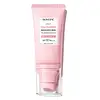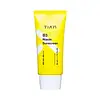What's inside
What's inside
 Key Ingredients
Key Ingredients

 Benefits
Benefits

 Concerns
Concerns

 Ingredients Side-by-side
Ingredients Side-by-side

Water
Skin ConditioningOctocrylene
UV AbsorberHomosalate
Skin ConditioningPhenylbenzimidazole Sulfonic Acid
UV AbsorberDimethicone
EmollientDimethicone/Silsesquioxane Copolymer
PEG-Crosspolymer
Butyl Methoxydibenzoylmethane
UV AbsorberEthylhexyl Salicylate
UV AbsorberBis-Ethylhexyloxyphenol Methoxyphenyl Triazine
Skin ConditioningNiacinamide
SmoothingMethylpropanediol
SolventSodium Stearoyl Glutamate
CleansingTromethamine
BufferingGlycerin
HumectantCurcuma Longa Root Extract
MaskingSilica Dimethyl Silylate
EmollientGlyceryl Stearates
EmollientJojoba Esters
EmollientCetyl Alcohol
EmollientStearyl Alcohol
EmollientButylene Glycol
HumectantPhenoxyethanol
PreservativeAcrylates/C10-30 Alkyl Acrylate Crosspolymer
Emulsion StabilisingHelianthus Annuus Seed Wax
Skin ConditioningEthylhexylglycerin
Skin ConditioningLactobacillus Ferment
Skin ConditioningCarbomer
Emulsion StabilisingSphingomonas Ferment Extract
Skin Conditioning1,2-Hexanediol
Skin ConditioningDisodium EDTA
Hydroxypropyl Cyclodextrin
MaskingDipropylene Glycol
HumectantPolyglycerin-3
HumectantPinus Densiflora Leaf Extract
AntimicrobialTocopherol
AntioxidantArbutin
AntioxidantGlutathione
Tranexamic Acid
AstringentCeramide EOP
Skin ConditioningCeramide NP
Skin ConditioningCeramide AP
Skin ConditioningPhytosphingosine
Skin ConditioningCholesterol
EmollientSodium Lauroyl Lactylate
EmulsifyingXanthan Gum
EmulsifyingUndecylenoyl Phenylalanine
Skin ConditioningWater, Octocrylene, Homosalate, Phenylbenzimidazole Sulfonic Acid, Dimethicone, Dimethicone/Silsesquioxane Copolymer, PEG-Crosspolymer, Butyl Methoxydibenzoylmethane, Ethylhexyl Salicylate, Bis-Ethylhexyloxyphenol Methoxyphenyl Triazine, Niacinamide, Methylpropanediol, Sodium Stearoyl Glutamate, Tromethamine, Glycerin, Curcuma Longa Root Extract, Silica Dimethyl Silylate, Glyceryl Stearates, Jojoba Esters, Cetyl Alcohol, Stearyl Alcohol, Butylene Glycol, Phenoxyethanol, Acrylates/C10-30 Alkyl Acrylate Crosspolymer, Helianthus Annuus Seed Wax, Ethylhexylglycerin, Lactobacillus Ferment, Carbomer, Sphingomonas Ferment Extract, 1,2-Hexanediol, Disodium EDTA, Hydroxypropyl Cyclodextrin, Dipropylene Glycol, Polyglycerin-3, Pinus Densiflora Leaf Extract, Tocopherol, Arbutin, Glutathione, Tranexamic Acid, Ceramide EOP, Ceramide NP, Ceramide AP, Phytosphingosine, Cholesterol, Sodium Lauroyl Lactylate, Xanthan Gum, Undecylenoyl Phenylalanine
Water
Skin ConditioningDibutyl Adipate
EmollientPropanediol
SolventMethylpropanediol
SolventTerephthalylidene Dicamphor Sulfonic Acid
UV Absorber1,2-Hexanediol
Skin ConditioningEthylhexyl Triazone
UV AbsorberNiacinamide
SmoothingPolymethylsilsesquioxane
Polysilicone-15
UV FilterTrimethylpentanediol/Adipic Acid/Glycerin Crosspolymer
Skin ConditioningTromethamine
BufferingCaprylyl Methicone
Skin ConditioningCetearyl Alcohol
EmollientDiethylamino Hydroxybenzoyl Hexyl Benzoate
UV FilterPolyglyceryl-3 Distearate
EmulsifyingMethyl Trimethicone
Skin ConditioningBis-Ethylhexyloxyphenol Methoxyphenyl Triazine
Skin ConditioningGlyceryl Stearate
EmollientPotassium Cetyl Phosphate
EmulsifyingAcrylates/C10-30 Alkyl Acrylate Crosspolymer
Emulsion StabilisingVp/Va Copolymer
Polyether-1
Alpha-Arbutin
AntioxidantCarbomer
Emulsion StabilisingDimethicone/Vinyl Dimethicone Crosspolymer
Skin ConditioningGlyceryl Stearate Citrate
EmollientPolyacrylate Crosspolymer-6
Emulsion StabilisingDimethicone Crosspolymer
Emulsion StabilisingGlycerin
HumectantAdenosine
Skin ConditioningCitrus Aurantium Bergamia Fruit Oil
MaskingPelargonium Graveolens Flower Oil
MaskingDisodium EDTA
Limonene
PerfumingCitronellol
PerfumingLinalool
PerfumingTranexamic Acid
AstringentGeraniol
PerfumingHydrogenated Lecithin
EmulsifyingPolyglyceryl-10 Stearate
Skin ConditioningPanthenol
Skin ConditioningSodium Ascorbyl Phosphate
AntioxidantTocopheryl Acetate
AntioxidantRose Flower Oil
MaskingGlyceryl Arachidonate
EmollientGlyceryl Linolenate
EmollientBiotin
AntiseborrhoeicFolic Acid
Skin ConditioningPyridoxine
Skin ConditioningRetinyl Palmitate
Skin ConditioningThiamine Hcl
MaskingCyanocobalamin
Skin ConditioningWater, Dibutyl Adipate, Propanediol, Methylpropanediol, Terephthalylidene Dicamphor Sulfonic Acid, 1,2-Hexanediol, Ethylhexyl Triazone, Niacinamide, Polymethylsilsesquioxane, Polysilicone-15, Trimethylpentanediol/Adipic Acid/Glycerin Crosspolymer, Tromethamine, Caprylyl Methicone, Cetearyl Alcohol, Diethylamino Hydroxybenzoyl Hexyl Benzoate, Polyglyceryl-3 Distearate, Methyl Trimethicone, Bis-Ethylhexyloxyphenol Methoxyphenyl Triazine, Glyceryl Stearate, Potassium Cetyl Phosphate, Acrylates/C10-30 Alkyl Acrylate Crosspolymer, Vp/Va Copolymer, Polyether-1, Alpha-Arbutin, Carbomer, Dimethicone/Vinyl Dimethicone Crosspolymer, Glyceryl Stearate Citrate, Polyacrylate Crosspolymer-6, Dimethicone Crosspolymer, Glycerin, Adenosine, Citrus Aurantium Bergamia Fruit Oil, Pelargonium Graveolens Flower Oil, Disodium EDTA, Limonene, Citronellol, Linalool, Tranexamic Acid, Geraniol, Hydrogenated Lecithin, Polyglyceryl-10 Stearate, Panthenol, Sodium Ascorbyl Phosphate, Tocopheryl Acetate, Rose Flower Oil, Glyceryl Arachidonate, Glyceryl Linolenate, Biotin, Folic Acid, Pyridoxine, Retinyl Palmitate, Thiamine Hcl, Cyanocobalamin
Ingredients Explained
These ingredients are found in both products.
Ingredients higher up in an ingredient list are typically present in a larger amount.
1,2-Hexanediol is a synthetic liquid and another multi-functional powerhouse.
It is a:
- Humectant, drawing moisture into the skin
- Emollient, helping to soften skin
- Solvent, dispersing and stabilizing formulas
- Preservative booster, enhancing the antimicrobial activity of other preservatives
Acrylates/C10-30 Alkyl Acrylate Crosspolymer is a synthetic polymer. It is used to thicken and improve the texture of products. Due to its properties, it can prevent water and oil ingredients from separating.
You might know this ingredient as Tinosorb S or Bemotrizinol. It is a UV filter that covers both UVA and UVB rays.
This ingredient has two peak UV absorption peaks ( 310 and 340 nm) and is able to absorb both UV-A and UV-B rays. This ingredient works by preventing UV rays from reaching and damaging your skin.
On top of that - it is highly photostable and helps prevent the photodegration of other sunscreen ingredients such as avobenzone.
Tinosorb S is allowed in the EU, Australia, and Asia. It is close to being approved by the FDA and we'll hopefully get this ingredient in the U.S. by late 2025.
Fun fact: Tinosorb S is the most effective UV absorber at maximum concentration (measured by SPF) permitted in the EU.
This ingredient is oil-soluble, so your oil-cleansers will take this right off at night.
Learn more about Bis-Ethylhexyloxyphenol Methoxyphenyl TriazineCarbomer is a polymer of acrylic acid. Its main role is to create a gel consistency.
A high amount of carbomer can cause pilling or balling up of products. Don't worry, most products contain 1% or less of carbomer.
Disodium EDTA plays a role in making products more stable by aiding other preservatives.
It is a chelating agent, meaning it neutralizes metal ions that may be found in a product.
Disodium EDTA is a salt of edetic acid and is found to be safe in cosmetic ingredients.
Learn more about Disodium EDTAGlycerin is already naturally found in your skin. It helps moisturize and protect your skin.
A study from 2016 found glycerin to be more effective as a humectant than AHAs and hyaluronic acid.
As a humectant, it helps the skin stay hydrated by pulling moisture to your skin. The low molecular weight of glycerin allows it to pull moisture into the deeper layers of your skin.
Hydrated skin improves your skin barrier; Your skin barrier helps protect against irritants and bacteria.
Glycerin has also been found to have antimicrobial and antiviral properties. Due to these properties, glycerin is often used in wound and burn treatments.
In cosmetics, glycerin is usually derived from plants such as soybean or palm. However, it can also be sourced from animals, such as tallow or animal fat.
This ingredient is organic, colorless, odorless, and non-toxic.
Glycerin is the name for this ingredient in American English. British English uses Glycerol/Glycerine.
Learn more about GlycerinMethylpropanediol is a synthetic solvent and humectant.
As a solvent, it helps dissolve other ingredients, helping to evenly distribute ingredients throughout the product. This ingredient has also been shown to have antimicrobial properties which makes it a preservative booster.
Methylpropanediol is able to add a bit of moisture to the skin. It also helps other ingredients be better absorbed into the skin, such as salicylic acid.
Learn more about MethylpropanediolNiacinamide is a multitasking form of vitamin B3 that strengthens the skin barrier, reduces pores and dark spots, regulates oil, and improves signs of aging.
And the best part? It's gentle and well-tolerated by most skin types, including sensitive and reactive skin.
You might have heard of "niacin flush", or the reddening of skin that causes itchiness. Niacinamide has not been found to cause this.
In very rare cases, some individuals may not be able to tolerate niacinamide at all or experience an allergic reaction to it.
If you are experiencing flaking, irritation, and dryness with this ingredient, be sure to double check all your products as this ingredient can be found in all categories of skincare.
When incorporating niacinamide into your routine, look out for concentration amounts. Typically, 5% niacinamide provides benefits such as fading dark spots. However, if you have sensitive skin, it is better to begin with a smaller concentration.
When you apply niacinamide to your skin, your body converts it into nicotinamide adenine dinucleotide (NAD). NAD is an essential coenzyme that is already found in your cells as "fuel" and powers countless biological processes.
In your skin, NAD helps repair cell damage, produce new healthy cells, support collagen production, strengthen the skin barrier, and fight environmental stressors (like UV and pollution).
Our natural NAD levels start to decline with age, leading to slower skin repair, visible aging, and a weaker skin barrier. By providing your skin niacinamide, you're recharging your skin's NAD levels. This leads to stronger, healthier, and younger looking skin.
Another name for vitamin B3 is nicotinamide. This vitamin is water-soluble and our bodies don't store it. We obtain Vitamin B3 from either food or skincare. Meat, fish, wheat, yeast, and leafy greens contain vitamin B3.
The type of niacinamide used in skincare is synthetically created.
Learn more about NiacinamideTranexamic Acid is best used for treating hyperpigmentation, discoloration, and melasma. It can also help build a stronger skin barrier.
Once applied, Tranexamic Acid starts decreasing inflammation from UV exposure. Tranexamic Acid also prevents our skin cells from meeting the pigment production cells.
Its brightening property makes it great at reducing the appearance of acne scars and marks.
Fun fact: Tranexamic Acid is also a medication used to reduce heavy bleeding.
This acid is derived from lysine, an amino acid.
Learn more about Tranexamic AcidTromethamine helps balance the pH and improve the texture of a product. It is synthetically created.
As an emulsifier, Tromethamine prevents oil and water ingredients from separating. This helps stabilize the product and elongate a product's shelf life. Tromethamine also makes a product thicker.
Tromethamine helps balance the pH level of a product. Normal pH level of skin is slightly acidic (~4.75-5.5). The acidity of our skin is maintained by our glands and skin biome. Being slightly acidic allows our skin to create an "acid mantle". This acid mantle is a thin barrier that protects our skin from bacteria and contaminants.
Oral Tromethanmine is an anti-inflammatory drug but plays the role of masking, adding fragrance, and/or balancing pH in skincare.
1,3-Propanediol, 2-amino-2-(hydroxymethyl)-
Learn more about TromethamineWater. It's the most common cosmetic ingredient of all. You'll usually see it at the top of ingredient lists, meaning that it makes up the largest part of the product.
So why is it so popular? Water most often acts as a solvent - this means that it helps dissolve other ingredients into the formulation.
You'll also recognize water as that liquid we all need to stay alive. If you see this, drink a glass of water. Stay hydrated!
Learn more about Water